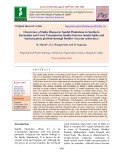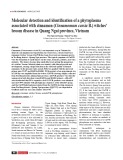
Phytoplasma infection
-
‘Candidatus Phytoplasma solani’ is endemic in Europe and infects a wide range of weeds and cultivated plants. Phytoplasmas are prokaryotic plant pathogens that colonize the sieve elements of their host plant, causing severe alterations in phloem function and impairment of assimilate translocation.
 21p
21p  visilicon2711
visilicon2711
 20-08-2021
20-08-2021
 15
15
 1
1
 Download
Download
-
Paulownia withes’-broom (PaWB) disease caused by phytoplasma is a serious infectious disease for Paulownia. However, the underlying molecular pathogenesis is not fully understood. Recent studies have demonstrated that histone modifications could play a role in plant defense responses to pathogens. But there is still no available genome-wide histone modification data in non-model ligneous species infected with phytoplasma.
 14p
14p  visilicon2711
visilicon2711
 20-08-2021
20-08-2021
 4
4
 1
1
 Download
Download
-
The WRKY gene family is one of the most important families in higher plants. As transcription factors, they actively respond to biotic and abiotic stress and are also involved in plant development. Chinese jujube (Ziziphus jujuba Mill.) is the largest type of dried fruit tree in China in terms of production, but its production is largely limited by phytoplasma infection, and the information about the role of WRKY genes under phytoplasma stress was still limited.
 14p
14p  visilicon2711
visilicon2711
 20-08-2021
20-08-2021
 12
12
 1
1
 Download
Download
-
Mitogen-activated protein kinase (MAPK) cascades play vital roles in signal transduction in response to a wide range of biotic and abiotic stresses. In a previous study, we identified ten ZjMAPKs and five ZjMAPKKs in the Chinese jujube genome. We found that some members of ZjMAPKs and ZjMAPKKs may play key roles in the plant’s response to phytoplasma infection.
 18p
18p  vijeeni2711
vijeeni2711
 24-07-2021
24-07-2021
 9
9
 0
0
 Download
Download
-
An intensive survey was conducted at flowering to ripening of capsule to record the incidence of charcoal rot in ten agroclimatic zones of Odisha during rabi 2014-15. Almost all the fields were infected by more than one disease. The major diseases of sesame recorded were Macrophomina stem and root rot, Cercospora leaf spot, Alternaria blight, powdery mildew, phytopthora blight and phyllody to some extent. Incidence of foliar diseases such as Alternaria blight, Powdery mildew, Cercospora leaf spot ranged from grade 2-4, 0-3 and 1-2 respectively with maximum incidence at Balianta.
 4p
4p  angicungduoc5
angicungduoc5
 14-06-2020
14-06-2020
 7
7
 0
0
 Download
Download
-
Phyllody is a serious disease of sesame caused by phytoplasma. Different types of disease symptoms are reported to be associated with sesame phyllody. The major symptoms are phyllody, Flower virescence, witches broom, shoot tip fasciation, flattening of the shoot apex and cracking of seed capsules. In addition to this, infected plants exhibit reduction of internode distance and of leaf size. Investigations were carried out on the symptomatology of phytoplasma associated with phyllody disease.
 16p
16p  angicungduoc5
angicungduoc5
 12-06-2020
12-06-2020
 12
12
 1
1
 Download
Download
-
Strawberry (Fragaria x ananassa Duchesne) is one of the most important commercial plants representing Rosaceae family. Like other fruit crops, strawberry is also known to be susceptible to diseases caused by fungi, bacteria and viruses. Since strawberry is propagated through runners year after year, the mother stocks often get infected with viruses pass on these viruses to the next progenies. Reports indicate that more than 30 viruses and phytoplasmas infect strawberry naturally.
 8p
8p  kequaidan4
kequaidan4
 05-05-2020
05-05-2020
 10
10
 1
1
 Download
Download
-
Phytoplasmas are plant pathogenic prokaryotes lacking cell wall, inhabiting phloem sieve elements in infected plants and have a unique life cycle among pathogens as they invade organisms of two distinct kingdoms, namely Plantae (plants) and Animalia (insects) and replicate intracellularly in both of them. Effectors are proteins secreted by a microbial pathogen into a host cell to enhance colonization and facilitate multiplication of the pathogens. In plants these effectors unload from the phloem to access distant tissues and alter basic developmental processes.
 13p
13p  cothumenhmong4
cothumenhmong4
 25-03-2020
25-03-2020
 9
9
 1
1
 Download
Download
-
Phytoplasmas are intracellular obligate prokaryotes that lack cell walls and have very small genomes (680–1,600 kb). Many fungal, bacterial and viral diseases have been characterized and resistant breeding programme is progressing very well. Recently, on the basis of the symptoms and on 16SrDNA sequence identity and phylogenetic relationships the association of ‘Ca. P. asteris’ with Rice Orange Leaf phytoplasma disease in South India was confirmed. Rice orange leaf phytoplasma was characterized based on multiple gene systems.
 11p
11p  caygaocaolon2
caygaocaolon2
 14-03-2020
14-03-2020
 9
9
 0
0
 Download
Download
-
China aster (Callistephus chinensis L. Nees.) is one of the important flower crop in India. It belongs to the family Asteraceae is native to China. Phyllody disease in China aster was first reported during 1986 from Bengaluru, India and known to be transmitted by Orosius albicinctus. The disease was characterized by chlorosis, upright growth, small leaf, short internode, stunting, profuse vegetative growth and phyllody (transformation of floral organs into leaf-like structures).
 7p
7p  caygaocaolon3
caygaocaolon3
 27-02-2020
27-02-2020
 19
19
 1
1
 Download
Download
-
DNA fingerprinting, estimation of molecular genetic diversity, marker assisted breeding and molecular diagnostic tools are the need of the hour for sugarcane crop improvement. Efficient extraction of genomic DNA (gDNA) free from polysaccharides, polyphenols, RNA and other major contaminants is a key to all these molecular activities. We present herewith, a modified DNA extraction protocol that has been optimized for isolating gDNA from endergonic and hardy sugarcane plant and its phytopathogens and endophytic fungi.
 9p
9p  chauchaungayxua3
chauchaungayxua3
 07-02-2020
07-02-2020
 9
9
 0
0
 Download
Download
-
Niger [Guizotia abyssinica (L.f.) Cass.] is one of the important minor oilseed crops in India. Phyllody disease on niger noticed for the first time at Main Research Station, Hebbal, Bengaluru, Karnataka. The molecular detection and characterization of the phytoplasma causing niger phyllody was investigated during Kharif 2016. The causal agent of the phyllody disease was identified based on symptoms, amplification of 16S rDNA of the phytoplasma by polymerase chain reaction (PCR) from infected samples, as well as by sequencing and phylogenetic analysis.
 8p
8p  cothumenhmong1
cothumenhmong1
 08-12-2019
08-12-2019
 16
16
 0
0
 Download
Download
-
The sandal spike disease is becoming serious threat to sandal cultivation in the southern states viz., Karnataka, Tamilnadu and Kerala. The high price of Sandal wood declared by the government of Karnataka and liberalization for the private cultivation of Sandal by valid license from the forestry department has encouraged the farmers to go for planting of Sandal on even very fertile soils. A number of Sandal plantations have also come up Karnataka. The disease incidence and prevalence in farmer’s sandal plantations was assessed by using complete enumeration method.
 6p
6p  nguaconbaynhay1
nguaconbaynhay1
 04-12-2019
04-12-2019
 13
13
 0
0
 Download
Download
-
Cinnamon (Cinnamomum cassia B.) is an important crop in Vietnam for domestic consumption and exportation. In recent years, a disease known as cinnamon witches’ broom (CinWB) has been discovered on cinnamon grown in Tra Bong district - Quang Ngai province. The typical symptoms of CinWB were the formation of small tumors on the stems, branches, petioles, and veins of plants. The tumors become long squid-like tassels giving the appearance of a witches’ broom. Infected plants are stunted, with delayed growth and development, causing a high reduction in the yield and quality of farmed cinnamon.
 4p
4p  caygaocaolon1
caygaocaolon1
 13-11-2019
13-11-2019
 11
11
 0
0
 Download
Download
CHỦ ĐỀ BẠN MUỐN TÌM








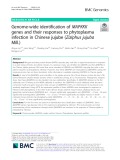
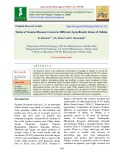
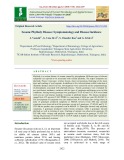



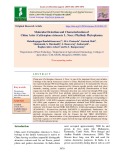

![Molecular detection and characterization of Niger [Guizotia abyssinica (L.f.) Cass] phyllody phytoplasma Molecular detection and characterization of Niger [Guizotia abyssinica (L.f.) Cass] phyllody phytoplasma](https://tailieu.vn/image/document/thumbnail/2019/20191208/cothumenhmong1/135x160/8381575821456.jpg)
